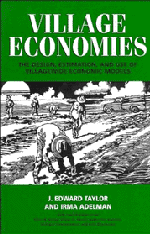Book contents
- Frontmatter
- Contents
- Acknowledgments
- 1 Introduction
- 2 Modeling village economies
- 3 The village economy and tenure security in West Africa: A Senegalese village SAM
- 4 Production and distribution in a dry-land village economy
- 5 Migration and the changing structure of a Mexican village economy
- 6 Economic linkages in a small regional economy: The case of Kutus Region, Kenya
- 7 Household nutrition and economic linkages: A village social accounting matrix for West Java, Indonesia
- 8 The village CGE: Basic model and estimation
- 9 Policy simulations
- 10 Conclusions
- Bibliography
- Index
6 - Economic linkages in a small regional economy: The case of Kutus Region, Kenya
Published online by Cambridge University Press: 05 June 2012
- Frontmatter
- Contents
- Acknowledgments
- 1 Introduction
- 2 Modeling village economies
- 3 The village economy and tenure security in West Africa: A Senegalese village SAM
- 4 Production and distribution in a dry-land village economy
- 5 Migration and the changing structure of a Mexican village economy
- 6 Economic linkages in a small regional economy: The case of Kutus Region, Kenya
- 7 Household nutrition and economic linkages: A village social accounting matrix for West Java, Indonesia
- 8 The village CGE: Basic model and estimation
- 9 Policy simulations
- 10 Conclusions
- Bibliography
- Index
Summary
This chapter offers an empirical study of the economic linkages that exist in one small region in Kenya. The region in question is defined by a market center and its hinterland. The chosen center is Kutus town, located in Kirinyaga district of Central Province in Kenya. Data collected to reveal production, consumption, income, and employment linkages in the Kutus area are used to estimate a social accounting matrix (SAM) for the region.
The chapter begins with some background information on the Kutus region; then the Kutus SAM is developed and presented; and finally the SAM is used to provide a further empirical picture of the local economy.
Kutus town and its hinterland
Kutus town is located in Kirinyaga District, Central Province. The district is located between latitude 1° 1' south and 0° 0.8' south and between longitude 37° and 38° east. It spans approximately 1,437 square kilometers, about 21 percent of which is occupied by Mount Kenya Forest. The district encompasses about 10.9 percent of the area of Central Province and 0.3 percent of the area of the entire nation. The district is bordered by Nyeri and Murang'a districts of Central Province and Embu and Machakos districts of Eastern Province.
Kutus lies virtually in the center of the district at the junction of the district's three divisions: Mwea, Ndia, and Gichugu. Kutus has been officially “twinned” with Kerugoya to form the Kerugoya-Kutus town council.
- Type
- Chapter
- Information
- Village EconomiesThe Design, Estimation, and Use of Villagewide Economic Models, pp. 122 - 145Publisher: Cambridge University PressPrint publication year: 1996
- 1
- Cited by



